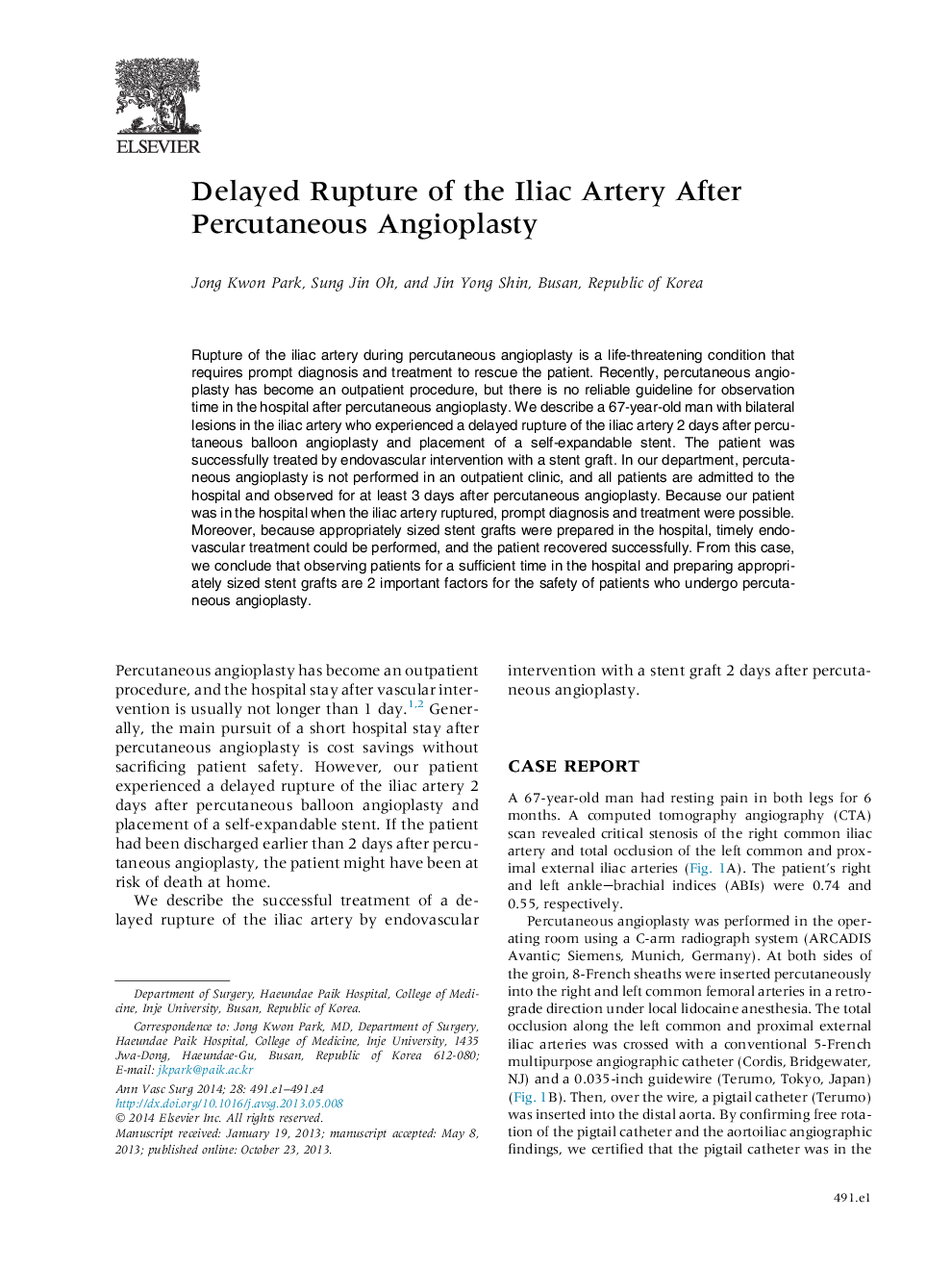| کد مقاله | کد نشریه | سال انتشار | مقاله انگلیسی | نسخه تمام متن |
|---|---|---|---|---|
| 2886355 | 1574213 | 2014 | 4 صفحه PDF | دانلود رایگان |
عنوان انگلیسی مقاله ISI
Delayed Rupture of the Iliac Artery After Percutaneous Angioplasty
ترجمه فارسی عنوان
پارگی سوزن ایلایاک پس از آنژیوپلاستی پوستی
دانلود مقاله + سفارش ترجمه
دانلود مقاله ISI انگلیسی
رایگان برای ایرانیان
ترجمه چکیده
پارگی عروق الاقصی در طی آنژیوپلاستی پوستی یک وضعیت تهدید کننده زندگی است که نیاز به تشخیص سریع و درمان برای نجات بیمار دارد. به تازگی، آنژیوپلاستی پوستی به یک روش سرپایی تبدیل شده است، اما هیچ روش قابل اطمینانی برای زمان مشاهده در بیمارستان پس از آنژیوپلاستی پوستی وجود ندارد. ما یک مرد 67 ساله با ضایعات دوطرفه در شریان قاعدگی را توصیف می کنیم که دو روز پس از آنژیوپلاستی بالون انسدادی و قرار دادن یک استنت قابل افزایش است. بیمار با مداخله آندوسکوپی با یک پیوند استنت تحت درمان قرار گرفت. در بخش ما، آنژیوپلاستی پوستی در یک کلینیک سرپایی انجام نمی شود و تمام بیماران بستری در بیمارستان می شوند و حداقل 3 روز پس از آنژیوپلاستی پوستی مشاهده می شوند. از آنجایی که بیمار ما در بیمارستان زمانی بود که سرخرگ ایلایک شکست خورده بود، تشخیص سریع و درمان امکان پذیر بود. علاوه بر این، چون گرافت های استنت مناسب اندازه گیری شده در بیمارستان، درمان انتروویک به موقع می تواند انجام شود و بیمار با موفقیت درمان می شود. از این مورد، ما نتیجه گرفتیم که رعایت بیماران برای زمان کافی در بیمارستان و آماده سازی مناسب گاستن سیتی، 2 عامل مهم برای ایمنی بیماران مبتلا به آنژیوپلاستی پوستی است.
موضوعات مرتبط
علوم پزشکی و سلامت
پزشکی و دندانپزشکی
کاردیولوژی و پزشکی قلب و عروق
چکیده انگلیسی
Rupture of the iliac artery during percutaneous angioplasty is a life-threatening condition that requires prompt diagnosis and treatment to rescue the patient. Recently, percutaneous angioplasty has become an outpatient procedure, but there is no reliable guideline for observation time in the hospital after percutaneous angioplasty. We describe a 67-year-old man with bilateral lesions in the iliac artery who experienced a delayed rupture of the iliac artery 2 days after percutaneous balloon angioplasty and placement of a self-expandable stent. The patient was successfully treated by endovascular intervention with a stent graft. In our department, percutaneous angioplasty is not performed in an outpatient clinic, and all patients are admitted to the hospital and observed for at least 3 days after percutaneous angioplasty. Because our patient was in the hospital when the iliac artery ruptured, prompt diagnosis and treatment were possible. Moreover, because appropriately sized stent grafts were prepared in the hospital, timely endovascular treatment could be performed, and the patient recovered successfully. From this case, we conclude that observing patients for a sufficient time in the hospital and preparing appropriately sized stent grafts are 2 important factors for the safety of patients who undergo percutaneous angioplasty.
ناشر
Database: Elsevier - ScienceDirect (ساینس دایرکت)
Journal: Annals of Vascular Surgery - Volume 28, Issue 2, February 2014, Pages 491.e1-491.e4
Journal: Annals of Vascular Surgery - Volume 28, Issue 2, February 2014, Pages 491.e1-491.e4
نویسندگان
Jong Kwon Park, Sung Jin Oh, Jin Yong Shin,
